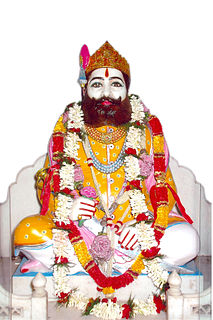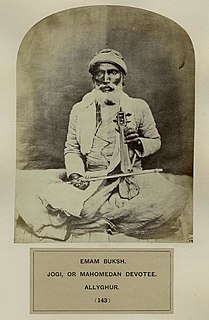Related Research Articles
Dhobi known in some places as Dhoba or Rajaka, Madivala is a group of community in India and the greater Indian subcontinent whose traditional occupations are washing and ironing, Cultivator, agricultural workers
Saini is a caste of North India who were traditionally landowners (zamindars) and farmers. Sainis claim to be descendants of a king, Shurasena, as well as of Krishna and Porus, and to be related to the ancient Shoorsaini clan, noted in Puranic literature. The Saini community is given representation in government jobs and educational institutes as an Other Backward Class (OBC) in the states of Uttar Pradesh, Punjab, Haryana, Rajasthan and Madhya Pradesh.

Dhangar is a herding caste of people found in the Indian states of Maharashtra, Karnataka, Goa, Madhya Pradesh and Uttar Pradesh. They are referred as Gadariya in North India. Goa and northern Karnataka, Golla or Kuruma (Kuruba) in Telangana & Andhra Pradesh and Karnataka Ahir in northern Maharashtra. and Gadariya in North India States like Uttar Pradesh, Madhya Pradesh, Bihar, haryana, Punjab, rajsthan, Chhattisgarh and Himachal Pradesh. Some Gavlis live in forested hill tracts of India's Western Ghats. Gavli, also known as Dange or Mhaske/khatik, Rabari ,gayri gadri ,Gaddi ,Baghel are sub-caste of Dhangar(Gadariya). However, there are many distinct Gavli castes in Maharashtra and Dhangar Gavli is one of them.

The Lohar, is a Shilpi Brahmin social group in India and Pakistan. Lohars have made weapons in various kingdoms from the start of civilization i.e. Hindu Rajas, Sikh Army, and European kingdoms.

Gurjar or Gujjar is an ethnic agricultural and pastoral community of India, Pakistan, and Afghanistan. Although traditionally they have been involved in agriculture, Gurjars are a large heterogeneous group that is internally differentiated in terms of culture, religion, occupation, and socio-economic status. The historical role of Gurjars has been quite diverse in society, at one end they have been founder of several kingdoms, dynasties, districts, cities, and towns, and at the other end, they are also nomads with no land of their own.

Agrahari, Agraharee or Agarhari is an Indian and Nepali Vaishya community, claimed to be descendants of legendary king Agrasena. Predominantly, they are found in the Indian state of Uttar Pradesh, Madhya Pradesh, Jharkhand, Chhattisgarh and Terai region of Nepal.
Bhatraju is an Indian caste of Telugu-speaking ballad reciters, panegyrists, and religious musicians.In Andhra Pradesh and Tamilnadu people of caste "Bhatraju" are considered to have come from Kshatriya blood line of Pandavas. Chandravansh Kshatriyas Vikramaditya and Bhatti denote some of the known ancestral origins of this community and that's where part of the name Bhat comes from. They are primarily found in the states of Andhra Pradesh and Telangana and also in smaller numbers in the neighbouring states. They are also known as Bhatturaju or Bhataraju or Bhatrajulu. After the fall of indigenous kingdoms, they switched to teacher and business..Bhatrajus are classified under the Other Backward Classes in most states of Southern India.
The Gadaria or Gadariya is an ethnic group that was traditionally involved professionally in livestock breeding, especially sheep. They are primarily found in Uttar Pradesh and in some parts of Punjab, Rajasthan, Madhya Pradesh and Bihar. In Gujarat, they are called Bharwad.
The Ghosi are a Muslim community found mainly in North India.

The Jogi is a Hindu community found in North India. Jogi surname is associated with the ancient migrants of the southern Indian states Karnataka, Andhra Pradesh, Tamil Nadu, and Kerala and Gujarat. They are collectively known as Nath, Jogi Nath, Jugi Nath, Nath Jogi, and Rawal and Rawal Dev Jogi in Gujarat state.
Shakumbhari or LoniaChauhan are a Hindu Chauhan Rajput, found in the state of Uttar Pradesh in India.
The Sainthwar, or Mall, are a group of Kshatriya castes settled from different locations to the Gorakhpur region. Sainthwar is not a single name but a group of Kshatriya that accepted the democratic Mall kingdom. They are landholders native to the Uttar Pradesh and Bihar states.
The Sikligar is a community found in the states of Gujarat, Haryana, Rajasthan and Punjab in India. They are also known as the Moyal and Panchal. They are Hindu in Gujarat, Telangana, Andhra Pradesh and Sikh in Punjab, and both Hindu and Sikh in Haryana.
Thakur is a historical feudal title of the Indian subcontinent. It is also used as a surname in the present day. The female variant of the title is Thakurani or Thakurain, and is also used to describe the wife of a Thakur.
The Golla, also spelt as Goalas are a Telugu-speaking pastoral community inhabited in the states of Andhra Pradesh, Telangana, Karnataka and Tamil Nadu. They represent 13.4% of the total population of Andhra Pradesh state. This caste is called by separate names in different regions, namely Gulla, Gullar, Gollewar, Gavali and Dhangar. They are classified as a Backward Caste.
The people of Jammu have the following traditional clothing:
Raut or Thethwar is an Indian caste, whose traditional occupation is herding. They are sub-divisions of Ahir (Yadav) caste.

The Jat reservation agitation was a series of violent protests in February 2016 by Jat people of North India, especially those in the state of Haryana, which "paralysed the State for 10 days.Jats come in general category in central as well as state list in haryana and punjab and obc only in state list in seven states but general in all over india in central list." The protestors sought inclusion of their caste in the Other Backward Class (OBC) category, which would make them eligible for affirmative action benefits. Besides Haryana, the protests also spread to the neighbouring states, such as Uttar Pradesh, Rajasthan, and the National Capital Region.
Sembadavar or Parvatha Rajakulam is a traditional fisherman community found mainly on the Coromandel coast of the Indian states of Tamil Nadu and Pondicherry. They also take the title Nattar. Sembadavar are a maritime community who are occupied primarily as inland and river fishermen and primarily fish with fishing net. A similar caste also known as Sambuni Reddi is found in Andhra Pradesh and Telangana. There are many theories as to their origins but they have since ancient times been recorded in the area of Tamil Nadu, Pondicherry and Sri Lanka.

Jaiswal or Jayswal or Jayaswal is a surname used by many Hindu communities. Jaiswals are mainly traders and deal in various commodities. In past, some of them excelled in the art of liquor making.
References
- 1 2 B R Sharma & A R Sankhyan 1996, p. 237.
- 1 2 Mahesh Sharma 2001, p. 68.
- 1 2 Mahesh Sharma 2001, p. 74.
- ↑ Kumar Suresh Singh 2003, p. 130.
- ↑ "Central List of OBCs". National Commission for Backward Classes. Retrieved 2 May 2018.
- ↑ Lalit Mohan (14 September 2016). "OBC committee members put up united front". The Tribune.
- ↑ Sud, Onkar Chand (1992). Administrative Problems of Rural Development in India. ISBN 9788185475158.